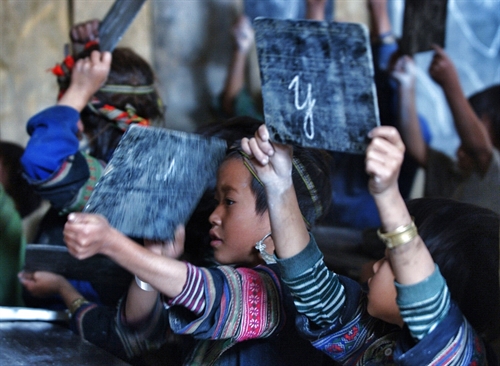 Society
Society

Ethnic minority children’s education has been improved by teaching in both their mother tongues and Vietnamese, research has showed.
 |
| Students at Lao Chải Primary School in Sa Pa District, northern Lào Cai Province. The Ministry of Education and Training and UNICEF Việt Nam implemented a bilingual education programme that helped improve quality and equality in education for ethnic minority children. — VNS Photo Việt Thanh |
HÀ NỘI — Ethnic minority children’s education has been improved by teaching in both their mother tongues and Vietnamese, research has showed.
Results from the action research on mother tongue-based bilingual education, released on Friday, showed that bilingual education is a feasible approach in Việt Nam.
The multi-ethnic nation has 53 ethnic minorities accounting for about 14 per cent of its population. Ethnic minorities reside mainly in mountainous, remote areas, facing difficulties in socio-economic development and education.
According to the report, students should access education through the language they understand best. When children are mostly guaranteed to be able to attend, their mother tongue should be used as long as possible.
In Việt Nam, seven ethnic minority languages – Chăm, Khmer, Ede, Bahnar, Jarai, Hmong and Chinese – are taught at 782 schools with more than 124,000 students in 20 provinces.
The pilot project on Mother Tongue-Based Bilingual Education was implemented by the Ministry of Education and Training in 2008 in collaboration with UNICEF in three provinces with high ethnic minority population densities - Lào Cai, Gia Lai and Trà Vinh in three languages - Hmong, Jarai and Khmer.
About 520 five-year-old children and 510 primary school students are engaged in the project.
Hà Đức Đà, director of Research Centre for Ethnic Minority Education, said that the project had helped improve education for ethnic minority children. Evidence gathered from the three pilot sites indicated that the programme had a substantial positive effect on students, teachers, education managers, parents and beneficiary communities.
“The children in bilingual classes made great strides in knowledge, skills and their attitude to study,” he said, adding that they became more confident and enjoyed school more than those in monolingual classes.
Students in bilingual classes were also more proficient in Vietnamese than those in monolingual classes, he said.
For example, in the northern mountainous province of Lào Cai, nearly 24 per cent of students in bilingual classes were rated "Excellent" in Vietnamese, about 46 per cent were rated "Good" and about 30 per cent were rated " Average". While in monolingual classes, only 20 per cent were rated "Excellent", 40 per cent were rated "Good" and 40 per cent were rated "Average".
Bilingual classes in the Cửu Long (Mekong) Delta province of Trà Vinh saw 55.5 per cent of students rated "Excellent", 22.3 per cent were rated "Good", and 11.2 per cent were rated "Average". In monolingual classes in Trà Vinh, 38.3 per cent were rated "Excellent", 39.7 per cent were rated "Good", 16.2 per cent were rated "Average", and the remaining 5.8 per cent were rated "Less than average".
An advantage of bilingual education was that when teachers/students failed to communicate in Vietnamese, they could shift to the students’ mother tongues, he said.
“It is obvious, though not yet generally recognised, that when children are learning in a language, which is not theirs, they are faced with a double set of challenges: not only do they need to learn a new language but they also need to learn new knowledge, new cultural norms and practices that are contained in that new language. Furthermore, these challenges might be exacerbated, for certain groups, who are already at risk of illiteracy, poverty and other vulnerabilities”, said Yoshimi Nishino, chief social policy and governance, UNICEF Việt Nam
She said that bilingual education could be very effective in improving education.
The success of the programme clearly showed that ethnic minority groups in Việt Nam may be better served and become socially and economically active if ethnic minority languages were used in other social services such as in healthcare and the legal sector, she said. — VNS




